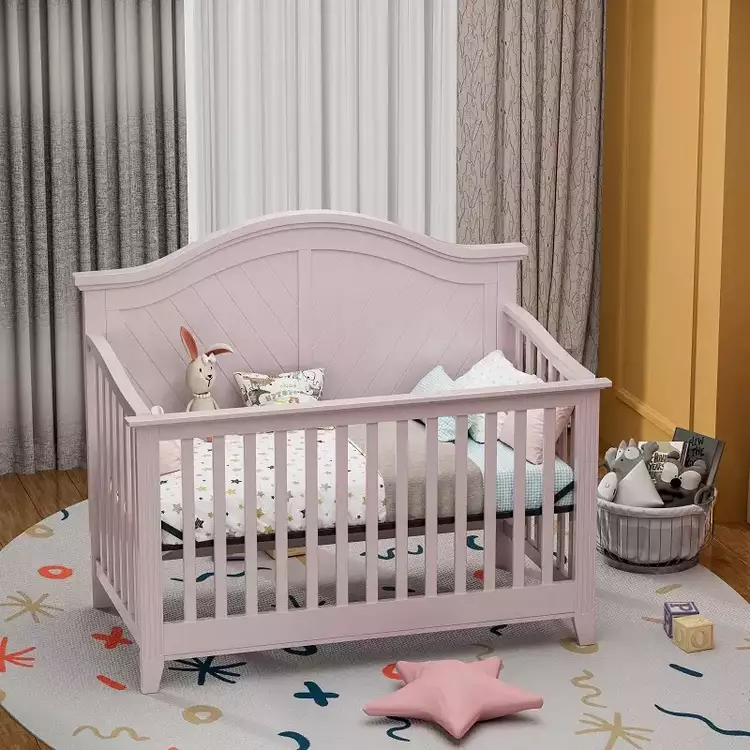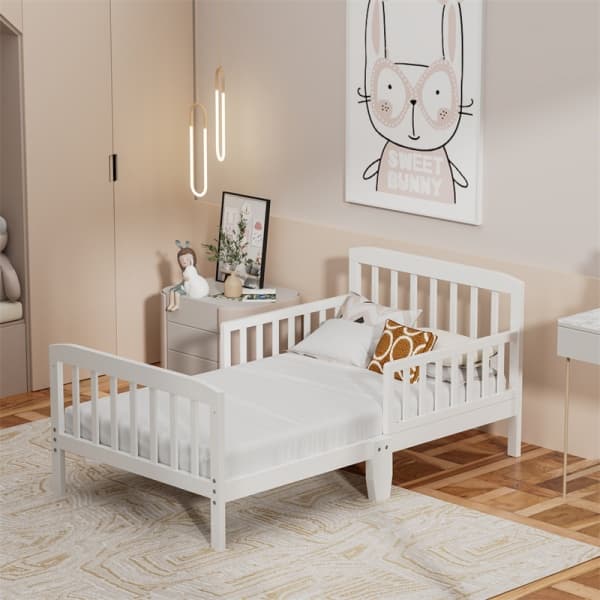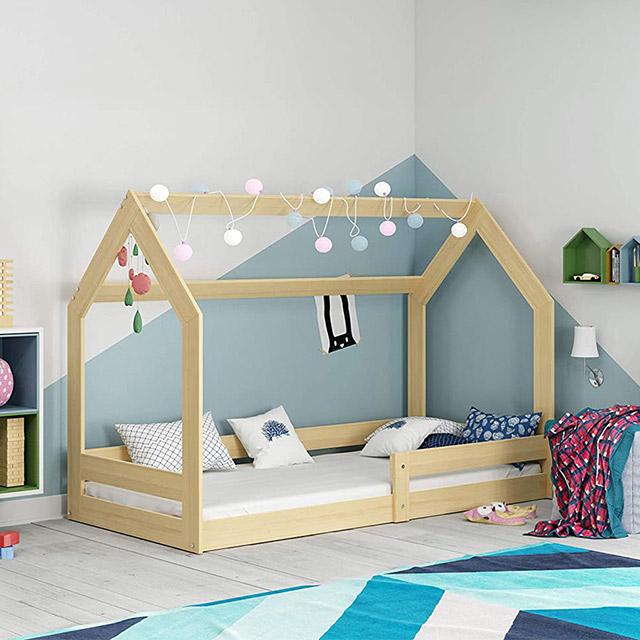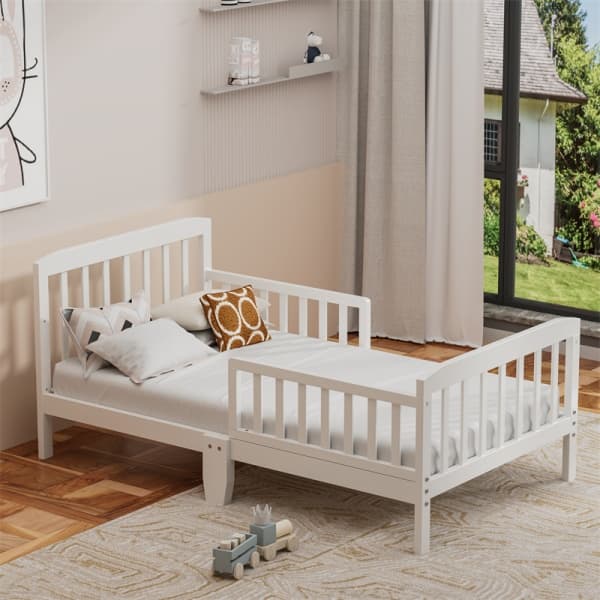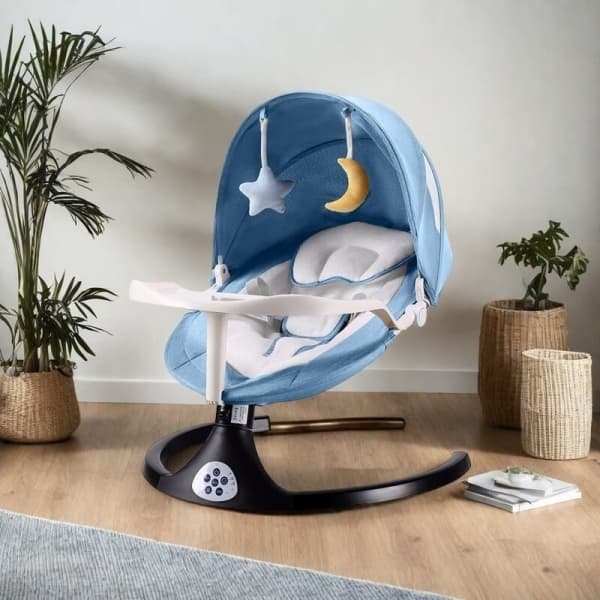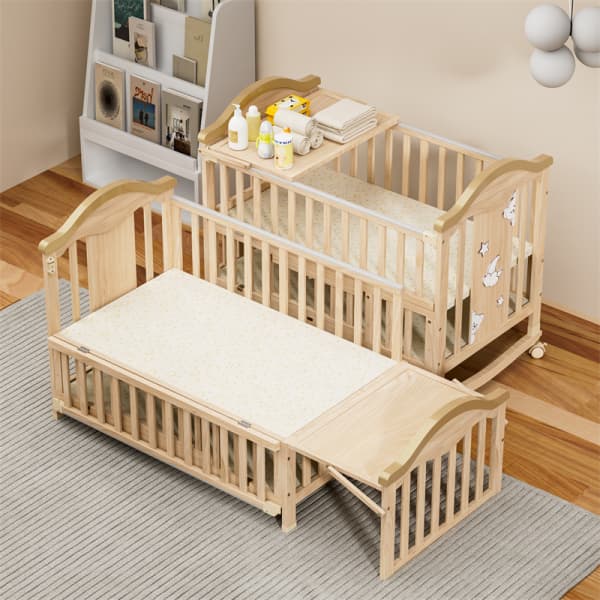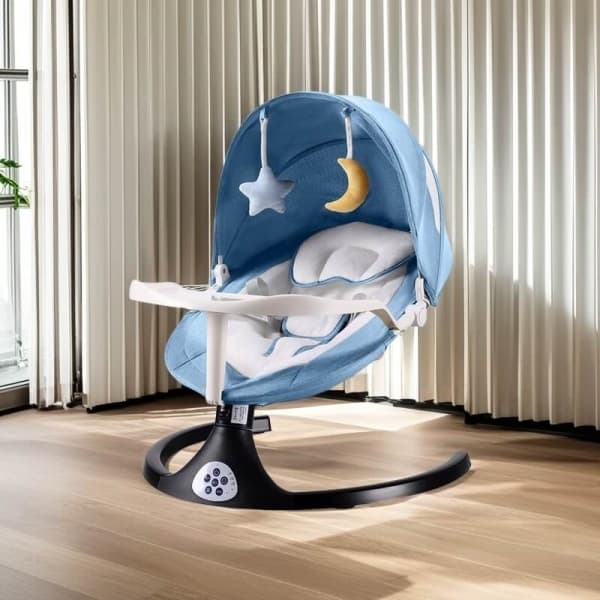Transição do seu filho de um berço para um berço é um marco significativo em seu crescimento e desenvolvimento. Esta decisão requer consideração cuidadosa de vários fatores, incluindo a idade do seu bebê, padrões de sono e sinais individuais de prontidão.
Neste guia abrangente, exploraremos as vantagens dos berços e moisés, ajudaremos você a identificar o momento ideal para a transição e forneceremos estratégias práticas para garantir um processo tranquilo e sem estresse.
Devo comprar um berço ou moisés para meu recém-nascido?
Antes do seu bebê chegar, você pode ter lutado centenas de vezes, comprando um berço ou uma alcofa. Cada opção tem sua própria aplicabilidade correspondente e diferentes vantagens. Entender essas vantagens pode ajudar você a fazer a melhor escolha.
Vantagens dos Berços
Berços são leves e fáceis de mover, o que os torna ideais para manter seu recém-nascido por perto, esteja você no quarto, na sala de estar ou até mesmo visitando a família.
Os berços são projetados para serem colocados bem ao lado da sua cama, permitindo que você alcance e cuide facilmente do seu bebê sem ter que se levantar e andar pelo quarto. Essa conveniência pode ser um salva-vidas durante aquelas sessões de alimentação tarde da noite.
Vantagens dos Berços
Berços podem ser usados desde a infância até a primeira infância, oferecendo um uso mais prolongado do que moisés, que normalmente são adequados apenas para os primeiros meses. Investir em um berço de alta qualidade pode ser uma escolha mais econômica a longo prazo.
Berços estão sujeitos a rígidas regulamentações de segurança e frequentemente vêm equipados com recursos como alturas de colchão ajustáveis, construção resistente e laterais de malha respirável. Esses recursos de segurança podem proporcionar paz de espírito aos pais.
Se você tem uma casa menor ou planeja dividir o quarto com seu bebê, um berço pode ser a opção mais prática inicialmente. No entanto, uma coisa que precisa ser entendida é que o berço só é adequado para uso nos primeiros meses do bebê. Eventualmente, o bebê precisará mudar para um berço.
Se seu bebê já usa um berço, continue lendo para se preparar para a transição dele para um berço!
Quando mover o bebê para o berço?
Embora não haja uma idade definitiva para a transição para um berço, a maioria dos especialistas recomenda fazer a troca entre 3 e 6 meses de idade. Nessa idade, os bebês geralmente estão prontos para um ambiente de sono mais espaçoso.
No entanto, é essencial observar os sinais individuais de prontidão do seu bebê em vez de confiar apenas na idade.
Alguns bebês podem estar prontos mais cedo, enquanto outros podem preferir o aconchego de um berço por um pouco mais de tempo. Se seu bebê usa um berço desde o nascimento, observe estes sinais que indicam que ele está preparado para mudar para um berço:
Aumento de tamanho e mobilidade: O limite de peso de um berço é geralmente 15 libras. Quando o peso do seu bebê se aproximar ou exceder o peso do fabricante, ou ele puder sustentar o corpo nas mãos e joelhos, ele deve imediatamente fazer a transição para um berço.
Maior tempo de sono: Quando seu bebê começa a dormir regularmente, dorme por muito tempo e não acorda mais no meio da noite para torturar você.
Rolando ou rastejando: Se o seu bebê começar a rolar ou engatinhar, você pode precisar de um berço mais largo e alto para garantir a segurança.
Como se preparar para a transição?
Fazer uma mudança não é algo fácil de fazer, tanto para adultos quanto para crianças. Você pode se preparar para a transição com antecedência para torná-la uma experiência suave e confortável para você e seu bebê.
1. Escolha o berço certo
Escolha um berço que atenda aos padrões de segurança atuais definidos por organizações como a Consumer Product Safety Commission (CPSC) ou a Juvenile Products Manufacturers Association (JPMA).
Compre um berço com um recurso de altura de colchão ajustável que esteja na moda. Dessa forma, você pode abaixar o colchão conforme seu bebê cresce e começa a ficar de pé ou se levantar.
Se você está procurando móveis que seu bebê possa usar por muito tempo, considere um berço conversível que pode ser transformado em uma cama infantil ou sofá-cama.
2. Monte o berçário
Decore o quarto com cores suaves, como azul, verde ou neutro. Essas cores podem criar uma atmosfera calmante e ajudar seu bebê a relaxar.
Mantenha o quarto do bebê arrumado organizando itens essenciais como fraldas, roupas e brinquedos. Use soluções de armazenamento como cestos e prateleiras para manter tudo ao alcance, mas fora da vista.
Prepare uma área para o berço longe de janelas e da luz solar direta para minimizar perturbações durante o sono.
Como fazer a transição do co-sleeping para o berço?
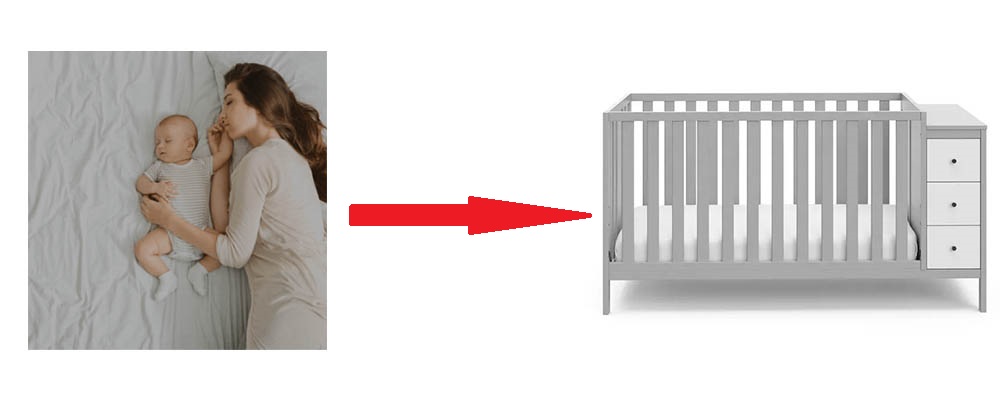
Os pediatras geralmente desaconselham que os bebês durmam com os pais, pois isso aumenta muito o risco de sufocamento acidental e aprisionamento.
Se você já fez isso nos estágios iniciais, então mova seu bebê para um berço dedicado o mais rápido possível. Mas é óbvio que os bebês já estão acostumados ao modo íntimo de co-sleeping, e inevitavelmente haverá muitos desafios na transição, que podem incluir os seguintes aspectos:
- Resistência à mudança: Os bebês são criaturas de hábitos e, quando estão longe dos pais, podem chorar e causar sofrimento emocional tanto aos bebês quanto aos pais.
- Ansiedade de separação: À medida que os bebês se tornam mais conscientes do ambiente, eles podem sentir ansiedade de separação quando são colocados em um berço. Isso pode se manifestar como aumento do choro ou dificuldade para adormecer.
- Sono interrompido: A transição inicial pode causar padrões de sono interrompidos. Bebês acostumados a dormir junto podem ter dificuldade para se acalmar no berço, resultando em despertares noturnos mais frequentes.
Aqui estão algumas maneiras de ajudar a suavizar a transição do sono compartilhado para o berço:
- Comece pequeno: Se possível, coloque o berço ao lado da sua cama. Dessa forma, seu bebê ainda pode sentir sua presença enquanto aprende a dormir em seu próprio espaço.
- Itens de conforto: Considere colocar um cobertor macio ou um bicho de pelúcia no berço com seu cheiro. Isso pode dar conforto e segurança ao seu bebê, ajudando-o a se ajustar a dormir sozinho.
- Tranquilizar: Se o seu bebê chorar no berço, responda logo para que ele sinta sua presença e se sinta tranquilo.
- Configuração de conforto: Certifique-se de que o berço esteja instalado confortavelmente. Use um colchão firme, lençóis com elástico e roupas de dormir apropriadas. O quarto deve ser escuro, silencioso e ter uma temperatura confortável.
Como fazer a transição do berço para o berço?
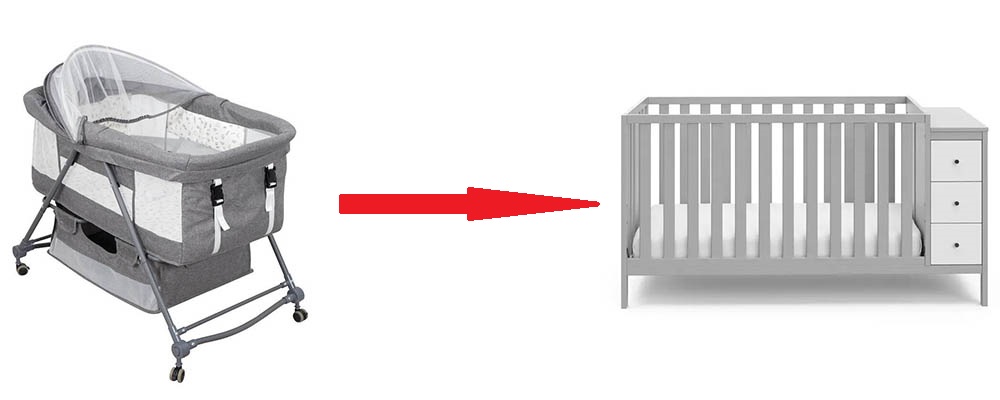
Obviamente, a transição de um berço para um berço é mais fácil do que a transição de um dormitório compartilhado, já que o bebê está apenas trocando o móvel em que dorme.
Mas, como mencionamos acima, os bebês podem ser um pouco resistentes a coisas novas, então os pais ainda precisam ter muita paciência e uma abordagem gentil durante a transição. Aqui estão alguns métodos que são um pouco semelhantes ao co-sleeping, mas diferentes.
- Comece com cochilos: Essa abordagem gradual pode ajudá-los a se adaptar ao novo espaço de sono sem a pressão imediata de uma noite inteira de sono.
- Mantenha um ambiente familiar: Para fazer o berço parecer mais familiar, tente replicar o ambiente do moisés. Use a mesma roupa de cama, manta ou saco de dormir.
- Seja consistente: Continue a colocar seu bebê para dormir no berço todas as noites para reforçar o novo espaço de sono. Com tempo e paciência, seu bebê se ajustará a dormir no berço, abrindo caminho para uma noite de sono tranquila.
E se meu bebê recusar o berço?
Bebês são propensos a ter medo e ansiedade ao encarar um novo ambiente, o que é uma dor de cabeça para os pais. Eles podem não conseguir falar ainda, mas suas reações parecem dizer que eles estão muito relutantes em usar a nova cama. O que você deve fazer?
A seguir estão alguns comportamentos de bebês que resistem ao berço e soluções.
1. Despertares noturnos
O novo ambiente de sono pode fazer com que seu bebê acorde com mais frequência durante a noite. Essa é uma preocupação comum para muitos pais, resultando em crianças e pais com sono ruim.
Neste momento, você precisa verificar cuidadosamente os motivos pelos quais o bebê acorda e chora. Ele está com fome, tem uma fralda molhada ou está doente? Você precisa encontrá-los um por um de acordo com a situação e resolvê-los adequadamente.
2. Ansiedade de separação
Por volta dos 6-9 meses, os bebês frequentemente sentem ansiedade de separação, o que os torna mais apegados e resistentes a ficar sozinhos no berço. Isso é normal, mas há uma série de métodos que você pode usar para aliviar esse sentimento.
Aumente gradualmente a distância entre você e seu bebê durante os horários de sono. Comece ficando no quarto até que seu bebê adormeça, então reduza gradualmente sua presença ao longo do tempo. Fale com uma voz calma e suave, e forneça toques suaves para confortar seu bebê.
Durante o dia, pratique separações curtas para ajudar seu bebê a se acostumar a ficar longe de você. Comece com períodos breves e aumente gradualmente a duração conforme seu bebê se sentir mais confortável.
Dicas para acalmar e confortar o bebê
A transição do seu bebê para o berço pode ser um momento desafiador, mas há várias estratégias que você pode usar para acalmar e confortar seu bebê, tornando a transição mais suave para todos os envolvidos. Aqui estão algumas dicas detalhadas:
1. Diminua as luzes: Reduzir as luzes do quarto sinaliza ao seu bebê que é hora de dormir. Um ambiente com pouca luz pode ajudar a produzir melatonina, o hormônio do sono.
2. Máquina de ruído branco: Uma máquina de ruído branco pode imitar os sons suaves que seu bebê ouviu no útero. Ela também pode abafar ruídos domésticos que podem acordar seu bebê.
3. Temperatura ambiente: Mantenha uma temperatura ambiente confortável entre 68-72°F (20-22°C). Superaquecimento ou muito frio podem atrapalhar o sono do seu bebê.
4. Toques suaves e silêncio: Quando seu bebê estiver no berço, dê tapinhas delicados em suas costas ou barriga e use um som calmante de “shhh”. Isso pode imitar a sensação e os sons de estar no útero.
5. Enfaixar: Para bebês mais novos que ainda não começaram a rolar, enfaixar pode dar uma sensação de segurança e evitar que reflexos de susto os acordem. Certifique-se de enfaixar com segurança para evitar quaisquer riscos.
6. Fique por perto inicialmente: Sente-se ao lado do berço até que seu bebê adormeça. Sua presença pode ser muito reconfortante. Reduza gradualmente a quantidade de tempo que você passa no quarto ao longo de várias noites.
7. Resposta consistente: Quando seu bebê acordar, responda consistentemente com uma rotina calmante. Evite pegá-lo no colo imediatamente; em vez disso, use tapinhas suaves e sons calmantes.
8. Ofereça uma chupeta: Se o seu bebê usa chupeta, oferecê-la pode ajudar a acalmá-lo e fazê-lo dormir novamente.
9. Tranquilize verbalmente: Use uma voz calma para tranquilizar seu bebê de que você está por perto. Repita frases como “Está na hora de dormir agora” ou “Mamãe/Papai está aqui.”
10. Breves check-ins: Se seu bebê estiver muito chateado, considere fazer check-ins rápidos. Entre no quarto, tranquilize-o sem pegá-lo no colo e saia novamente. Aumente gradualmente o tempo entre os check-ins.
Conclusão
Lembre-se, cada bebê é único, e a transição pode levar tempo. Ofereça segurança e apoio durante todo o processo, e comemore cada pequena vitória enquanto seu bebê se ajusta ao seu novo santuário de sono.
Com paciência, consistência e um toque carinhoso, você logo encontrará seu pequeno dormindo pacificamente em seu berço aconchegante, pronto para embarcar no próximo capítulo de crescimento e descoberta.
Artigos relacionados recomendados:
- Os 20 maiores fabricantes de berços em 2025
- Berço de cabeceira: Guia definitivo para anexar à cama dos pais
- Melhores berços portáteis: guia para a festa do pijama dos avós
- Guia completo dos melhores berços para espaços pequenos
- 10 marcas de mini berços mais bem avaliadas de 2025
- Os 20 melhores fabricantes de berços para bebês nos EUA – Clafbebe
- Melhores berços para bebês em 2025: um guia completo – Clafbebe


